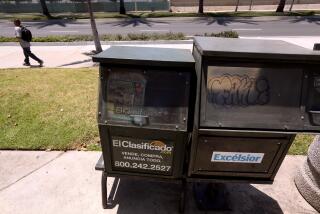TV of the Public by the Public and for the Public
- Share via
For a long time, the only time people watched or heard about public access television was when it became the subject of a national news story on TV. White Aryan Resistance leader Tom Metzger, a rebel with a cause, stirred up the press when he used the platform for electronic free speech to show his “Race and Reason” program. Porno magazine publisher Al Goldstein raised some eyebrows when he titillated New York with “Midnight Blue,” a nude public access talk show.
Earlier this month, the Orange County producers of “Secret Passions,” the nation’s first homosexual soap opera, reportedly sent their program to local public access channels because it was the only arena where they believed they could find air time.
But community programmers insist that such controversial programming is no longer the norm. Public access viewing audiences are expanding because the producers are getting more sophisticated.
Public access is a permanent fixture in roughly 2,000 of the 9,010 cable systems in the United States, including Copley/Colony Cablevision in Orange County. The service is part of the franchise agreements that city and county governments arrange with cable companies.
With public access, anyone can be a producer.
“The normal guy who sits down at home in front of his television set can relate to us,” said Omar White, a direct-mail advertiser and public access producer in Costa Mesa. The 37-year-old spends most of his spare time producing “Fish Report,” a half-hour cable program for local fisherman. In one episode, White went shark fishing off the Newport Beach coast.
“Public access is kind of a nuts-and-bolts approach to television,” White said. “You learn how to balance production budgets, schedule shoots, write scripts. It brings television down to the community level. I’m not some guy from New York who shows up in a box on the TV screen. I go to the grocery market in town and people recognize me.”
“The main advantage of public access is the freedom,” Sarah Kuhn of Costa Mesa said. “I’m able to do whatever topics interest me.” The 55-year-old telemarketer produces “People, Places and Things,” a magazine show that deals with sensitive topics such as AIDS, battered women, drunk driving, drama therapy and pregnancy options.
“I like to think I’m offering something to the community,” Kuhn said.
Other producers with Copley/ Colony have created programs that range from a health show to community theater productions to a sort of “Two on the Town” for teen-agers produced by local Girl Scouts.
The Federal Communications Commission first mandated public access in 1972. Growth of public access in Southern California was slow to catch on, due in part to the abundance of local television programming and a scattered patchwork of cable TV systems.
“In Los Angeles there is no one public access center, no one entity that is responsible for creating a community image,” said Sharon Ingraham, chairwoman of the National Federation of Local Cable Programmers in Washington, D.C. “In a smaller community, the public access channel may be the only form of local television available. It draws the community together because it’s where people turn to for local news, issues and events.”
To help stimulate public access in Orange County, cities such as Costa Mesa and Cypress offer grants of up to several thousand dollars to producers to help ease production costs.
“We obviously don’t have the money to work with that the networks do, but then again, you don’t have to deal with the politics,” said Shelly Lash, a member of the Costa Mesa Cable Television Committee, which advises the City Council on grant funds. “There’s no excuse for complaining what’s on television when you can do your own show.”
The only qualifications to sign up for the free public access certification classes are that producers must be 18 years old, or accompanied by a certified adult producer, and live or work in the cable-service area. In addition, productions are exclusively for local programming and cannot be used for commercial purposes.
Roger Heaney and his twin brother Ryan of Cypress used part of their $500 grant to rent fog machines to produce a 20-minute “sight and sound fantasy” called “Touch the Horizon,” a tale about the last girl on Earth following World War III. For the 23-year-old brothers’ next production, a musical extravaganza called “Prowl,” they are building sets, designing costumes, renting laser units, composing original music and featuring a cast of 30 dancers.
“When it comes down to it, not a whole lot of people are interested in doing production work,” Roger Heaney said. “Sure, people look at it and it looks really glamorous. But when you go out and actually do it, you realize how much work producing a TV show really is.”
More to Read
The complete guide to home viewing
Get Screen Gab for everything about the TV shows and streaming movies everyone’s talking about.
You may occasionally receive promotional content from the Los Angeles Times.






